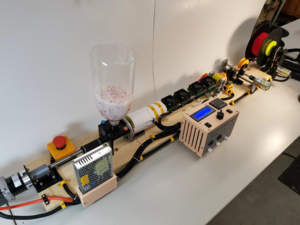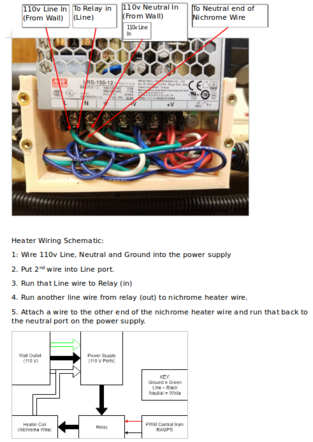A recyclebot is an affordable waste plastic extruder that produces high-quality 3-D printing filament from post-consumer polymer waste. Using open-source hardware and techniques from the RepRap 3-D printer community, the recyclebot allows researchers to explore recycled materials for new applications in material science.
Source
- Aubrey L. Woern, Joseph R. McCaslin, Adam M. Pringle, and Joshua M. Pearce. RepRapable Recyclebot: Open Source 3-D Printable Extruder for Converting Plastic to 3-D Printing Filament. HardwareX 4C (2018) e00026 doi: https://doi.org/10.1016/j.ohx.2018.e00026 open access
- Just the code: OSF
- FreeCAD users: On the OSF link above the entire assembly is available in the STP file. Open it in FreeCAD and pick what part you would like to modify, export it as.stp, and you will be left with just the part you need. Once you have that, you can save it as just about anything.
- Smaller FreeCAD 55 MB version - compliments of Marcin at Open Source Ecology - removed all the nuts and bolts and screws
- Please note that all the instructions are in the HardwareX article above
Updates and Improvements[edit | edit source]
- Motor, Thrust bearing, Hopper, and Flange assembly for a DIY Filament Extruder by Bill Dube - This simple redesign made a huge difference in how smoothly the machine runs. The auger thrust is fully resolved symmetrically about the auger. This redesign also corrected the tangential "pinch" in the hopper that would trap the pellets. Additionally, the center-line distance was some random number, and the sketches were not always anchored to the center line, so the parts where out of alignment as well as portions of the hopper were randomly out of alignment with other parts. This is all fixed.
- Filament Diameter (thickness) Measurement (sensor) for DIY Extruder, Dial indicator mountby Bill Dube
Open Source Ecology Improvements[edit | edit source]
- OSE 3D printable roller - https://osf.io/9hsmb/
Abstract

In order to assist researchers explore the full potential of distributed recycling of post-consumer polymer waste, this article describes a recyclebot, which is a waste plastic extruder capable of making commercial quality 3-D printing filament. The device design takes advantage of both the open source hardware methodology and the paradigm developed by the open source self-replicating rapid prototyper (RepRap) 3-D printer community. Specifically, this paper describes the design, fabrication and operation of a RepRapable Recyclebot, which refers to the Recyclebot's ability to provide the filament needed to largely replicate the parts for the Recyclebot on any type of RepRap 3-D printer. The device costs less than $700 in mate rials and can be fabricated in about 24 h. Filament is produced at 0.4 kg/h using 0.24 kWh/kg with a diameter ±4.6%. Thus, filament can be manufactured from commercial pellets for <22% of commercial filament costs. In addition, it can fabricate recycled waste plastic into filament for 2.5 cents/kg, which is <1000X commercial filament costs. The system can fabricate filament from polymers with extrusion temperatures <250 °C and is thus capable of manufacturing custom filament over a wide range of thermopolymers and composites for material science studies of new materials and recyclability studies, as well as research on novel applications of fused filament based 3-D printing.
See also[edit source]
RepRapable Recyclebot and the Wild West of Recycling[edit source]
Recycling Technology[edit source]
- Recyclebot
- RepRapable Recyclebot: Open source 3-D printable extruder for converting plastic to 3-D printing filament
- Open Source 3-D Filament Diameter Sensor for Recycling, Winding and Additive Manufacturing Machines
- Improving recyclebot concepts
- 3-D Printable Polymer Pelletizer Chopper for Fused Granular Fabrication-Based Additive Manufacturing
- Mechanical Properties of Direct Waste Printing of Polylactic Acid with Universal Pellets Extruder: Comparison to Fused Filament Fabrication on Open-Source Desktop Three-Dimensional Printers
- Fused Particle Fabrication 3-D Printing: Recycled Materials' Optimization and Mechanical Properties
- Multi-material distributed recycling via material extrusion: recycled high density polyethylene and poly (ethylene terephthalate) mixture
- Mechanical Properties and Applications of Recycled Polycarbonate Particle Material Extrusion-Based Additive Manufacturing
- Wood Furniture Waste-Based Recycled 3-D Printing Filament
- Solar powered distributed customized manufacturing
- Mechanical Properties of Ultraviolet-Assisted Paste Extrusion and Postextrusion Ultraviolet-Curing of Three-Dimensional Printed Biocomposites
- Open Source Waste Plastic Granulator
- Open-Source Grinding Machine for Compression Screw Manufacturing
- Sustainability and Feasibility Assessment of Distributed E-Waste Recycling using Additive Manufacturing in a Bi-Continental Context
- Finding Ideal Parameters for Recycled Material Fused Particle Fabrication-Based 3D Printing Using an Open Source Software Implementation of Particle Swarm Optimization
- Waste Plastic Direct Extrusion Hangprinter
- Hangprinter for Large Scale Additive Manufacturing using Fused Particle Fabrication with Recycled Plastic and Continuous Feeding
Distributed Recycling LCA[edit source]
- Tightening the loop on the circular economy: Coupled distributed recycling and manufacturing with recyclebot and RepRap 3-D printing
- Technical pathways for distributed recycling of polymer composites for distributed manufacturing: Windshield wiper blades
- Plastic recycling in additive manufacturing: A systematic literature review and opportunities for the circular economy
- Energy Payback Time of a Solar Photovoltaic Powered Waste Plastic Recyclebot System
- Life cycle analysis of distributed recycling of post-consumer high density polyethylene for 3-D printing filament
- Evaluation of Potential Fair Trade Standards for an Ethical 3-D Printing Filament
- Life cycle analysis of distributed polymer recycling
- Distributed recycling of post-consumer plastic waste in rural areas
- Ethical Filament Foundation
- Green Fab Lab Applications of Large-Area Waste Polymer-based Additive Manufacturing
- Systems Analysis for PET and Olefin Polymers in a Circular Economy
- Potential of distributed recycling from hybrid manufacturing of 3-D printing and injection molding of stamp sand and acrylonitrile styrene acrylate waste composite
- Towards Distributed Recycling with Additive Manufacturing of PET Flake Feedstocks
Literature Reviews[edit source]

- Waste plastic extruder: literature review
- Life cycle analysis of polymer recycling literature review
- Solar powered recyclebot literature review
- Waste plastic extruder: literature review
- Life cycle analysis of polymer recycling literature review
Externals[edit source]
- Economist article on U. of Washington's HDPE boat, Oprn3dp.me
- https://ultimaker.com/en/resources/52444-ocean-plastic-community-project
- Another possible solution - reusable containers [1]
- Commercial https://dyzedesign.com/pulsar-pellet-extruder/
- ---
- Cruz, F., Lanza, S., Boudaoud, H., Hoppe, S., & Camargo, M. Polymer Recycling and Additive Manufacturing in an Open Source context: Optimization of processes and methods. [2]
- Investigating Material Degradation through the Recycling of PLA in Additively Manufactured Parts
- Mohammed, M.I., Das, A., Gomez-Kervin, E., Wilson, D. and Gibson, I., EcoPrinting: Investigating the use of 100% recycled Acrylonitrile Butadiene Styrene (ABS) for Additive Manufacturing.
- Kariz, M., Sernek, M., Obućina, M. and Kuzman, M.K., 2017. Effect of wood content in FDM filament on properties of 3D printed parts. Materials Today Communications. [3]
- Kaynak, B., Spoerk, M., Shirole, A., Ziegler, W. and Sapkota, J., 2018. Polypropylene/Cellulose Composites for Material Extrusion Additive Manufacturing. Macromolecular Materials and Engineering, p.1800037. [4]
- O. Martikka et al., "Mechanical Properties of 3D-Printed Wood-Plastic Composites", Key Engineering Materials, Vol. 777, pp. 499-507, 2018 [5]
- Yang, T.C., 2018. Effect of Extrusion Temperature on the Physico-Mechanical Properties of Unidirectional Wood Fiber-Reinforced Polylactic Acid Composite (WFRPC) Components Using Fused Deposition Modeling. Polymers, 10(9), p.976. [6]
- Romani, A., Rognoli, V., & Levi, M. (2021). Design, Materials, and Extrusion-Based Additive Manufacturing in Circular Economy Contexts: From Waste to New Products. Sustainability, 13(13), 7269. https://www.mdpi.com/2071-1050/13/13/7269/pdf
Literature Reviews[edit | edit source]

- Solar powered recyclebot literature review
- Waste plastic extruder: literature review
- Life cycle analysis of polymer recycling literature review
In the News[edit | edit source]
- Michigan Tech Researchers Publish Paper on New Recyclebot 3D Printer- 3D Print, Ichiban Electronics
- Recyclebot an Open-Source 3D Printable Extruder for Converting Plastic to 3D Printing Filament - Inside 3D Printing
- RepRapable Recyclebot: Open-Source-Extruder recycelt Filament - Make Germany (1521)
- LSWDD turns recyclable plastics into 3D printer filament - The Island's Weekly
- [https://3dprint.com/215471/michigan-tech-r
- Recycle at Home with 3D Printing - Machine Design
- Equipment spotlight: Boost for at-home filament extrusion - Plastics Recycling Update
- Plastic-eating robot turns waste into printer filament HardwareX 616
- 3D Printing is Turning the Economics of Scale on its Head Cape and Islands (listen)
- 3D printers inspire creativity and help those in need Newsday 11.7k
- Papers
- Recyclebot
- Michigan
- USA
- MOST
- Polymer recycling
- MOST completed projects and publications
- 3D printing
- Recycling
- Rural community development
- Polymers
- Plastic
- Plastic bottles
- SDG12 Responsible consumption and production
- Sustainable development
- Distributed manufacturing
- Life cycle analysis
- Open source hardware
- Open hardware
- Materials science
- Energy efficiency







